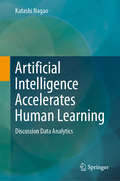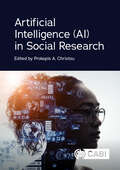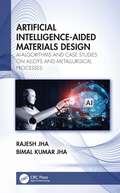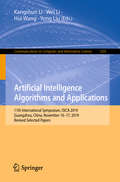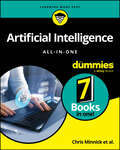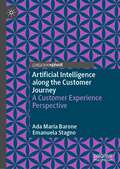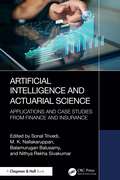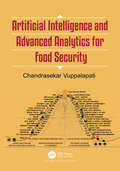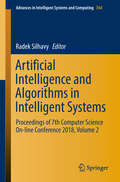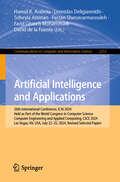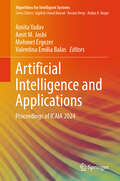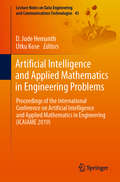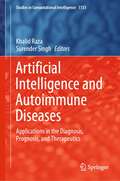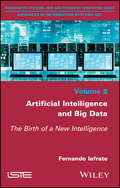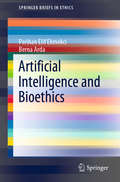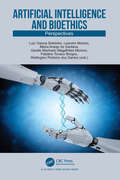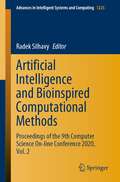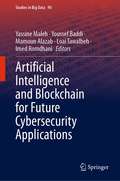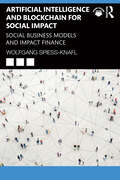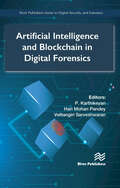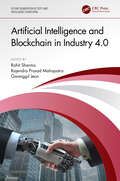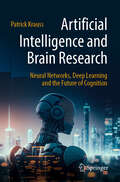- Table View
- List View
Artificial Intelligence (2nd edition)
by Patrick H. WinstonThis is an eagerly awaited revision of the single bestselling introduction to Artificial Intelligence ever published. It retains the best features of the earlier works including superior readability, currency, and excellence in the selection of the examples.
Artificial Intelligence Accelerates Human Learning: Discussion Data Analytics
by Katashi NagaoFocusing on students’ presentations and discussions in laboratory seminars, this book presents case studies on evidence-based education using artificial intelligence (AI) technologies. It proposes a system to help users complete research activities, and a machine-learning method that makes the system suitable for long-term operation by performing data mining for discussions and automatically extracting essential tasks. By illustrating the complete process – proposal, implementation, and operation – of applying machine learning techniques to real-world situations, the book will inspire researchers and professionals to develop innovative new applications for education. The book is divided into six chapters, the first of which provides an overview of AI research and practice in education. In turn, Chapter 2 describes a mechanism for applying data analytics to student discussions and utilizing the results for knowledge creation activities such as research. Based on discussion data analytics, Chapter 3 describes a creative activity support system that effectively utilizes the analytical results of the discussion for subsequent activities. Chapter 4 discusses the incorporation of a gamification method to evaluate and improve discussion skills while maintaining the motivation to participate in the discussion. Chapters 5 and 6 describe an advanced learning environment for honing students’ discussion and presentation skills. Two important systems proposed here are a presentation training system using virtual reality technologies, and an interactive presentation/discussion training system using a humanoid robot. In the former, the virtual space is constructed by measuring the three-dimensional shape of the actual auditorium, presentations are performed in the same way as in the real world, and the AI as audience automatically evaluates the presentation and provides feedback. In the latter, a humanoid robot makes some remarks on and asks questions about students’ presentations, and the students practice responding to it.
Artificial Intelligence (AI) in Social Research
The field of social research is characterized by its broad scope and interdisciplinary nature, encompassing the examination of human behaviour, societies, and various facets of social existence; however, it is influenced by numerous factors, including technological advancements. It is therefore no surprise that Artificial Intelligence (AI) has rapidly become a driving force, bringing about substantial transformations within the field. The use of AI-assisted tools and programmes for the collection, analysis, and interpretation of both quantitative and qualitative data is increasing at a remarkable pace. The implications of utilizing these applications are significant and noteworthy. While these technologies present numerous opportunities, it is important to acknowledge the accompanying dilemmas and risks associated with this form of technological advancement. With a focus on AI's research implications, this book explores various considerations and examples across different disciplines of social research. It highlights the considerable promise AI holds for revolutionizing the discipline while also guiding readers in contemplating the potential drawbacks and various concerns. By doing so, researchers can optimize the capabilities of AI and promote its responsible, reliable, and beneficial application in enhancing and advancing social research.
Artificial Intelligence-Aided Materials Design: AI-Algorithms and Case Studies on Alloys and Metallurgical Processes
by Rajesh Jha Bimal Kumar JhaThis book describes the application of artificial intelligence (AI)/machine learning (ML) concepts to develop predictive models that can be used to design alloy materials, including hard and soft magnetic alloys, nickel-base superalloys, titanium-base alloys, and aluminum-base alloys. Readers new to AI/ML algorithms can use this book as a starting point and use the MATLAB® and Python implementation of AI/ML algorithms through included case studies. Experienced AI/ML researchers who want to try new algorithms can use this book and study the case studies for reference. Offers advantages and limitations of several AI concepts and their proper implementation in various data types generated through experiments and computer simulations and from industries in different file formats Helps readers to develop predictive models through AI/ML algorithms by writing their own computer code or using resources where they do not have to write code Covers downloadable resources such as MATLAB GUI/APP and Python implementation that can be used on common mobile devices Discusses the CALPHAD approach and ways to use data generated from it Features a chapter on metallurgical/materials concepts to help readers understand the case studies and thus proper implementation of AI/ML algorithms under the framework of data-driven materials science Uses case studies to examine the importance of using unsupervised machine learning algorithms in determining patterns in datasets This book is written for materials scientists and metallurgists interested in the application of AI, ML, and data science in the development of new materials.
Artificial Intelligence Algorithm Design for Systems: Proceedings of 13th Computer Science Online Conference 2024, Volume 3 (Lecture Notes in Networks and Systems #1120)
by Radek Silhavy Petr SilhavyThis volume delves into the application of Artificial Intelligence within systems and network environments. Highlighted papers investigate the latest in neural network applications, optimisation strategies, and hybrid bio-inspired algorithms. It includes the rigorously reviewed proceedings of the Artificial Intelligence Application in Networks and Systems session of the 13th Computer Science Online Conference 2024 (CSOC 2024), held online in April 2024.
Artificial Intelligence Algorithms and Applications: 11th International Symposium, ISICA 2019, Guangzhou, China, November 16–17, 2019, Revised Selected Papers (Communications in Computer and Information Science #1205)
by Kangshun Li Wei Li Hui Wang Yong LiuThis book constitutes the thoroughly refereed proceedings of the 11th International Symposium on Intelligence Computation and Applications, ISICA 2019, held in Guangzhou, China, in November 2019.The 65 papers presented were carefully reviewed and selected from the total of 112 submissions. This volume features the most up-to-date research in evolutionary algorithms, parallel computing and quantum computing, evolutionary multi-objective and dynamic optimization, intelligent multimedia systems, virtualization and AI applications, smart scheduling, intelligent control, big data and cloud computing, deep learning, and hybrid machine learning systems.The papers are organized according to the following topical sections: new frontier in evolutionary algorithms; evolutionary multi-objective and dynamic optimization; intelligent multimedia systems; virtualization and AI applications; smart scheduling; intelligent control; big data and cloud computing; statistical learning.
Artificial Intelligence All-in-One For Dummies
by John Paul Mueller Sheryl Lindsell-Roberts Paul Mladjenovic Stephanie Diamond Shiv Singh Chris Minnick Luca Massaron Daniel Stanton Pam Baker Jeffrey AllanA comprehensive roadmap to using AI in your career and in your life Artificial intelligence is everywhere. Major software organizations like Microsoft, Google, and Apple have built AI directly into products and invited the world to become part of the AI revolution. And it's impossible to use these tools to their fullest potential without understanding the basics of what AI is and what it can do. Artificial Intelligence All-in-One For Dummies compiles insight from the expert authors of AI books in the For Dummies series to provide an easy-to-follow walkthrough for anyone interested in learning how to use AI. You'll learn how to put artificial intelligence to work for you and your company in a wide variety of situations, from creating office assistants to managing projects and marketing your products. Inside the book: How to prompt AI platforms like ChatGPT and Copilot while avoiding “hallucinations” and other bugs Strategies for adding artificial intelligence tools to your company's existing workflows to improve efficiency and generate new opportunities Techniques to improve your programming capabilities with AI or create new AI-powered tools Perfect for professionals curious about the potential and pitfalls associated with generative artificial intelligence, Artificial Intelligence All-in-One For Dummies shows you exactly how AI works and how you can apply it in your own professional and personal life.
Artificial Intelligence along the Customer Journey: A Customer Experience Perspective
by Ada Maria Barone Emanuela StagnoThe development of several AI solutions has revolutionized the way in which consumers behave. Serving as a guide to the role that AI plays on different aspects of consumers’ life, this book provides a comprehensive understanding of the main artificial intelligence (AI) solutions available in the market. In particular, the authors adopt a customer experience approach to investigate how different AI technologies play a role at different stages of the customer journey (e.g., from pre-purchase to post-purchase decisions). Covering a range of technologies, such as augmented reality, voice assistants, chatbots and robots, readers will be able to learn which strategies and AI solutions are more effective at different stages of the customer journey.
Artificial Intelligence and Actuarial Science: Applications and Case Studies from Finance and Insurance
by Sonal Trivedi Nallakaruppan M. K Balamurugan Balusamy Nithya Rekha SivakumarThis book aims to explore how to automate, innovate, design, and deploy emerging technologies in actuarial work transformations for the insurance and finance sector. It examines the role of artificial intelligence with process automation in daily monitoring of solvency, governance, compliance, data processes, etc. It also explores the usage of machine learning, telematics system, AI-enabled claim processing software, Big Data and Algorithms, Explainable AI, and AI-enabled risk management tools in various actuarial processes.This book:• Presents case studies and best practices with real-world examples of successful and unsuccessful actuarial work transformation initiatives and transformation with emerging technologies• Offers deployment solutions for different applications of AI in actuarial work• Discusses how organizations can effectively incorporate AI into their current practices of actuarial work• Covers diverse emerging technologies, practices, and processes of actuaries from around the globe• Elaborates upon a framework for comprehending how big data and AI developments may affect insurance offers and their supervision• Explains how insurance companies may review and modify their current Risk Management Framework (RMF) to take into account some of the significant differences while implementing AI use casesThis reference book is for scholars, researchers and professionals interested in Artificial Intelligence and Actuarial Science.
Artificial Intelligence and Advanced Analytics for Food Security
by Chandrasekar VuppalapatiClimate change, increasing population, food-versus-fuel economics, pandemics, etc. pose a threat to food security to unprecedented levels. It has fallen upon the practitioners of agriculture and technologists of the world to innovate and become more productive to address the multi-pronged food security challenges. Agricultural innovation is key to managing food security concerns. The infusion of data science, artificial intelligence (AI), advanced analytics, satellites data, geospatial data, climatology, sensor technologies, and climate modeling with traditional agricultural practices such as soil engineering, fertilizers use, and agronomy are some of the best ways to achieve this. Data science helps farmers to unravel patterns in fertilizer pricing, equipment usage, transportation and storage costs, yield per hectare, and weather trends to better plan and spend resources. AI enables farmers to learn from fellow farmers to apply best techniques that are transferred learning from AI to improve agricultural productivity and to achieve financial sustainability. Sensor technologies play an important role in getting real-time farm field data and provide feedback loops to improve overall agricultural practices and can yield huge productivity gains. Advanced Analytics modeling is essential software technique that codifies farmers’ tacit knowledge such as better seed per soil, better feed for dairy cattle breed, or production practices to match weather pattern that was acquired over years of their hard work to share with worldwide farmers to improve overall production efficiencies, the best antidote to food security issue. In addition to the paradigm shift, economic sustainability of small farms is a major enabler of food security. The book reviews all these technological advances and proposes macroeconomic pricing models that data mines macroeconomic signals and the influence of global economic trends on small farm sustainability to provide actionable insights to farmers to avert any financial disasters due to recurrent economic crises.
Artificial Intelligence and Algorithms in Intelligent Systems: Proceedings Of 7th Computer Science On-line Conference 2018, Volume 2 (Advances In Intelligent Systems And Computing #764)
by Radek SilhavyThis book presents the latest trends and approaches in artificial intelligence research and its application to intelligent systems. It discusses hybridization of algorithms, new trends in neural networks, optimisation algorithms and real-life issues related to the application of artificial methods.The book constitutes the second volume of the refereed proceedings of the Artificial Intelligence and Algorithms in Intelligent Systems of the 7th Computer Science On-line Conference 2018 (CSOC 2018), held online in April 2018.
Artificial Intelligence and Applications: 26th International Conference, ICAI 2024, Held as Part of the World Congress in Computer Science, Computer Engineering and Applied Computing, CSCE 2024, Las Vegas, NV, USA, July 22–25, 2024, Revised Selected Papers (Communications in Computer and Information Science #2252)
by Hamid R. Arabnia Leonidas Deligiannidis Soheyla Amirian Farzan Shenavarmasouleh Farid Ghareh Mohammadi David de la FuenteThis book constitutes the proceedings of the 26th International Conference on Artificial Intelligence and Applications, ICAI 2024, held as part of the 2024 World Congress in Computer Science, Computer Engineering and Applied Computing, in Las Vegas, USA, during July 22 to July 25, 2024. The 38 full papers included in this book were carefully reviewed and selected from 376 submissions. They have been organized in topical sections as follows: Deep convolutional neural networks, ANNs, and applications; machine learning and novel applications; large language models and applications; data science, recognition and authentication methods and applications; artificial intelligence and applications; XXIV Technical Session on Applications of Advanced AI Techniques to information management for solving company-related problems.
Artificial Intelligence and Applications: Proceedings of ICAIA 2024 (Algorithms for Intelligent Systems)
by Amita Yadav Amit M. Joshi Mehmet Ergezer Valentina Emilia BalasThe papers in this book are high quality refereed papers presented at ICAIA 2024, the second International conference on Artificial Intelligence and Applications, held at Maharaja Surajmal Institute of Technology, New Delhi in collaboration with Wentworth Institute of Technology, Boston, USA in March 2024. This book presents new and innovative developments and applications in machine learning, data mining, neural networks, computation optimisation technologies, followed by research applications in signals, language and classification, prediction, recommendations, and systems. This book is essential for researchers and practitioners in this field.
Artificial Intelligence and Applied Mathematics in Engineering Problems: Proceedings of the International Conference on Artificial Intelligence and Applied Mathematics in Engineering (ICAIAME 2019) (Lecture Notes on Data Engineering and Communications Technologies #43)
by D. Jude Hemanth Utku KoseThis book features research presented at the 1st International Conference on Artificial Intelligence and Applied Mathematics in Engineering, held on 20–22 April 2019 at Antalya, Manavgat (Turkey). In today’s world, various engineering areas are essential components of technological innovations and effective real-world solutions for a better future. In this context, the book focuses on problems in engineering and discusses research using artificial intelligence and applied mathematics. Intended for scientists, experts, M.Sc. and Ph.D. students, postdocs and anyone interested in the subjects covered, the book can also be used as a reference resource for courses related to artificial intelligence and applied mathematics.
Artificial Intelligence and Autoimmune Diseases: Applications in the Diagnosis, Prognosis, and Therapeutics (Studies in Computational Intelligence #1133)
by Khalid Raza Surender SinghThe book provides an overview of various autoimmune disorders and how artificial intelligence (AI) and machine learning will be used for the diagnosis, prognosis, and treatment of these disorders. AI algorithms are used to create synthetic patient populations with the properties of actual patient cohorts, build personalized predictive models of drug combinations and unravel complex relationships between diet, microbiome, and genetic line-up to determine the comparative treatment response. The book highlights clinical applications and challenges of AI for the diagnosis and treatment/management of autoimmune disorders which includes Rheumatoid Arthritis (RA), Multiple Sclerosis (MS), Type I Diabetes, Psoriatic Arthritis (PsA), and other critical diseases.
Artificial Intelligence and Big Data: The Birth of a New Intelligence
by Fernando IafrateWith the idea of “deep learning” having now become the key to this new generation of solutions, major technological players in the business intelligence sector have taken an interest in the application of Big Data. In this book, the author explores the recent technological advances associated with digitized data flows, which have recently opened up new horizons for AI. The reader will gain insight into some of the areas of application of Big Data in AI, including robotics, home automation, health, security, image recognition and natural language processing.
Artificial Intelligence and Big Data for Financial Risk Management: Intelligent Applications (Banking, Money and International Finance)
by Hassan M. Kabir Metawa Saad Metawa NouraThis book presents a collection of high-quality contributions on the state-of-the-art in Artificial Intelligence and Big Data analysis as it relates to financial risk management applications. It brings together, in one place, the latest thinking on an emerging topic and includes principles, reviews, examples, and research directions. The book presents numerous specific use-cases throughout, showing practical applications of the concepts discussed. It looks at technologies such as eye movement analysis, data mining or mobile apps and examines how these technologies are applied by financial institutions, and how this affects both the institutions and the market. This work introduces students and aspiring practitioners to the subject of risk management in a structured manner. It is primarily aimed at researchers and students in finance and intelligent big data applications, such as intelligent information systems, smart economics and finance applications, and the internet of things in a marketing environment.
Artificial Intelligence and Bioethics (SpringerBriefs in Ethics)
by Perihan Elif Ekmekci Berna ArdaThis book explores major bioethical issues emerging from the development and use of artificial intelligence in medical settings. The authors start by defining the past, present and future of artificial intelligence in medical settings and then proceed to address the resulting common and specific bioethical inquiries. The book discusses bioethical inquiries in two separate sets. The first set is comprised of ontological discussions mainly focusing on personhood and being an ethical agent of an artefact. The second set discusses bioethical issues resulting from the use of artificial intelligence. It focuses particularly on the area of artificial intelligence use in medicine and health services. It addresses the main challenges by considering fundamental principles of medical ethics, including confidentiality, privacy, compassion, veracity and fidelity. Finally, the authors discuss the ethical implications of involvement of artificial intelligence agents in patient care by expanding on communication skills in a case-based approach. The book is of great interest to ethicists, medical professionals, academicians, engineers and scientists working with artificial intelligence.
Artificial Intelligence and Bioethics: Perspectives
by Luiz Vianna Sobrinho Leandro Modolo Maíra Araújo de Santana Giselle Machado Magalhães Moreno Fabiano Tonaco Borges Wellington Pinheiro dos SantosThe fourth industrial revolution challenges humanity ethically and morally: mass unemployment, new forms of colonialism, and mass-and-granular surveillance are a few examples of these challenges. Nevertheless, the industrial revolutions have increased human productivity and quality of life. This book aims to review the ethical challenges related to the use of these technologies. It unfolds bioethical perspectives regarding Artificial Intelligence (AI) and its impact on life on earth. It discusses both northern and southern epistemologies of bioethics. Northern bioethics comprises principles of autonomy, beneficence, non-maleficence, and justice. Southern bioethics gives weightage to struggles for human liberation, social justice, and the pluralism of knowledge. The book discusses topics from aging to mass surveillance, to deliver a universal bioethical guideline to a wide range of professions that work with AI and are concerned about its impact on life. This book will not label AI, but broaden the readers' view of an ethical and explainable AI that works for life on earth.
Artificial Intelligence and Bioinspired Computational Methods: Proceedings of the 9th Computer Science On-line Conference 2020, Vol. 2 (Advances in Intelligent Systems and Computing #1225)
by Radek SilhavyThis book gathers the refereed proceedings of the Artificial Intelligence and Bioinspired Computational Methods Section of the 9th Computer Science On-line Conference 2020 (CSOC 2020), held on-line in April 2020.Artificial intelligence and bioinspired computational methods now represent crucial areas of computer science research. The topics presented here reflect the current discussion on cutting-edge hybrid and bioinspired algorithms and their applications.
Artificial Intelligence and Blockchain for Future Cybersecurity Applications (Studies in Big Data #90)
by Yassine Maleh Youssef Baddi Mamoun Alazab Loai Tawalbeh Imed RomdhaniThis book presents state-of-the-art research on artificial intelligence and blockchain for future cybersecurity applications. The accepted book chapters covered many themes, including artificial intelligence and blockchain challenges, models and applications, cyber threats and intrusions analysis and detection, and many other applications for smart cyber ecosystems. It aspires to provide a relevant reference for students, researchers, engineers, and professionals working in this particular area or those interested in grasping its diverse facets and exploring the latest advances on artificial intelligence and blockchain for future cybersecurity applications.
Artificial Intelligence and Blockchain for Social Impact: Social Business Models and Impact Finance
by Wolfgang Spiess-KnaflArtificial Intelligence and Blockchain for Social Impact provides an accessible overview of artificial intelligence (AI) and blockchain technologies, and explores their applications for social enterprise and impact investing. The opening chapter introduces the impact space, exploring different social business models, the role of technology, the impact investing market and general problems in the space. The remainder of this book falls into two paths: the first focusing on AI and the other looking at the blockchain technology. Providing introductions to each of these technologies and their histories, the author goes on to examine them from the perspectives of social business models and impact finance. A concluding chapter explores AI and cryptocurrencies in the impact space in the future. Readers are supported with international case studies and other student-friendly features. Situated at the intersection between technology, fintech, social enterprise, impact investing and social impact, this book is a valuable resource for upper-level courses across all these areas. It also offers an introduction to this emerging topic for researchers and business professionals. Online teaching resources to accompany this book include instructor lecture slides and data sets.
Artificial Intelligence and Blockchain in Digital Forensics (River Publishers Series in Digital Security and Forensics)
by P. Karthikeyan Hari Mohan Pandey Velliangiri SarveshwaranDigital forensics is the science of detecting evidence from digital media like a computer, smartphone, server, or network. It provides the forensic team with the most beneficial methods to solve confused digital-related cases. AI and blockchain can be applied to solve online predatory chat cases and photo forensics cases, provide network service evidence, custody of digital files in forensic medicine, and identify roots of data scavenging. The increased use of PCs and extensive use of internet access, have meant easy availability of hacking tools. Over the past two decades, improvements in the information technology landscape have made the collection, preservation, and analysis of digital evidence extremely important. The traditional tools for solving cybercrimes and preparing court cases are making investigations difficult. We can use AI and blockchain design frameworks to make the digital forensic process efficient and straightforward. AI features help determine the contents of a picture, detect spam email messages and recognize swatches of hard drives that could contain suspicious files. Blockchain-based lawful evidence management schemes can supervise the entire evidence flow of all of the court data. This book provides a wide-ranging overview of how AI and blockchain can be used to solve problems in digital forensics using advanced tools and applications available on the market.
Artificial Intelligence and Blockchain in Industry 4.0 (Future Generation of Soft and Intelligent Computing)
by Rohit Sharma Rajendra Prasad Mahapatra Gwanggil JeonThe book addresses the challenges in designing blockchain-based secured solutions for Industry 4.0 applications using artificial intelligence. It further provides a comparative analysis of various advanced security approaches such as edge computing, cybersecurity, and cloud computing in the realm of information technology. This book: • Address the challenges in designing blockchain-based secured solutions for Industry 4.0 applications using artificial intelligence • Provides a comparative analysis of various advanced security approaches such as edge computing, cybersecurity, and cloud computing in the realm of information technology • Discusses the evolution of blockchain and artificial intelligence technology, from fundamental theories to practical aspects • Illustrates the most recent research solutions that handle the security and privacy threats while considering the resource-constrained in Industry 4.0 devices • Showcases the methods and tools necessary for intelligent data analysis and gives solutions to problems resulting from automated data collection The text aims to fill the gap between the theories of blockchain and its practical application in business, government, and defense among other areas. It further highlights the challenges associated with the use of blockchain for various industry 4.0 applications such as data analytics, software-defined networks, cyber-physical systems, drones, and cybersecurity. The text is primarily written for senior undergraduate, graduate students, and academic researchers in the fields of electrical engineering, electronics and communication engineering, computer engineering, manufacturing engineering, and industrial engineering.
Artificial Intelligence and Brain Research: Neural Networks, Deep Learning and the Future of Cognition
by Patrick KraussHow does artificial intelligence (AI) work and are there parallels to the human brain? What do natural and artificial intelligence have in common, and what are the differences? Is the brain nothing more than a biological computer? What are neural networks and how can the term deep learning be explained simply?Since the cognitive revolution in the middle of the last century, AI and brain research have been closely intertwined. There have been several spectacular breakthroughs in the field of AI in recent years, from alphaGo to DALL-E 2 and ChatGPT, which were completely unthinkable until recently. However, researchers are already working on the innovations of tomorrow, such as hybrid machine learning or neuro-symbolic AI. But what does this actually mean?Based on current research findings and exciting practical examples, this non-fiction book provides an understandable introduction to the basics and challenges of these fascinating disciplines. You will learn what neuroscience and psychology know about how the brain works and how artificial intelligence works. You will also learn how AI has revolutionized our understanding of the brain and how findings from brain research are used in computer science to further develop AI algorithms. Discover the fascinating world of these two disciplines. Find out why artificial intelligence and brain research are two sides of the same coin and how they will shape our future.

